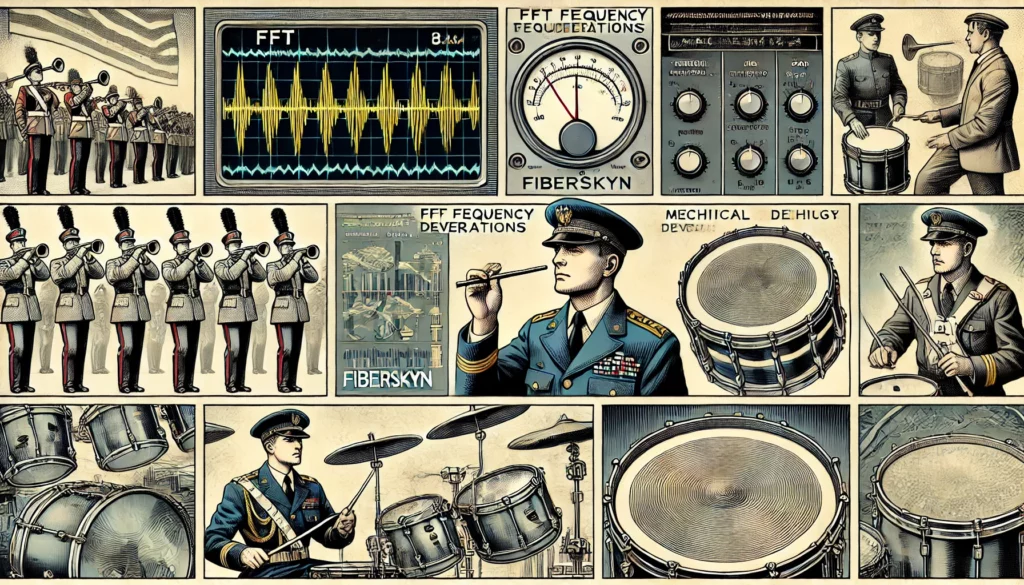Snare Drum Hoops Comparison
Very useful, and toneful!
===
Drum hoops are the metal rims that hold the drumhead in place on a drum shell. There are several types of drum hoops, including triple-flange hoops, die-cast hoops, and S-hoops, each with its own characteristics and advantages. Here’s an overview of each:
1. Triple-Flange Hoops: Triple-flange hoops are the most common type of drum hoop and are made from a thin, rolled metal strip with three bends or flanges along the edge. These hoops are lightweight and flexible, allowing for a more open and resonant drum sound. They also provide a good balance between rimshot durability and drumhead responsiveness, making them suitable for a wide range of playing styles and musical genres.
2. Die-Cast Hoops: Die-cast hoops are made from a solid piece of metal that is cast or molded into shape. They are thicker and heavier than triple-flange hoops, providing greater rigidity and stability to the drumhead. Die-cast hoops are known for their enhanced rimshot durability, increased tuning stability, and a more focused and controlled sound compared to triple-flange hoops. They are often preferred for heavier playing styles such as rock and metal, where rimshot consistency and projection are important.
3. S-Hoops: S-hoops are a variation of triple-flange hoops with an inward curve or “S” shape along the edge. This design provides a smoother and more comfortable playing surface for drummers while still retaining the flexibility and resonance of triple-flange hoops. S-hoops are said to enhance rimshot consistency and reduce hand fatigue during extended playing sessions. They are available in various configurations, including flanged S-hoops and hybrid S-hoops with die-cast sections for added rigidity and durability.
Each type of drum hoop offers distinct advantages and characteristics, and the choice between them depends on factors such as playing style, musical genre, personal preference, and the desired sound and feel of the drum. Drummers often experiment with different types of hoops to find the combination that best suits their individual needs and preferences.

A structured analysis contrasting the key drum hoop styles—specifically 1.6mm triple-flanged, 2.3mm triple-flanged, die-cast hoops, and other notable variants—highlighting their distinct impacts on playability, resonance, tonal characteristics, and tuning behaviors:
1. 1.6mm Triple-Flange Hoops
Playability and Feel:
- Very flexible, offering more give during rimshots, resulting in a lighter, responsive feel under the stick.
- Encourages subtler playing dynamics due to less rigidity, enhancing sensitivity.
Resonance and Ringiness:
- Maximum resonance with greater openness, higher sustain, and pronounced overtones due to the reduced mass and stiffness.
- Tends to sound more open, lively, and “ringy,” ideal for vintage, jazz, or subtle acoustic settings.
Tone and Complexity:
- Rich, complex overtone structures; more harmonic variation due to hoop flexibility allowing head vibrations and non-uniformities.
- Can produce a less controlled, but characteristically nuanced tonal response.
Head Hold-Down:
- Moderate; thinner hoops exert less even downward pressure, allowing minor tension inconsistencies.
- Easier to detune intentionally or accidentally; local lug adjustments significantly impact immediate vicinity, introducing non-uniform tonalities and micro-varieties.
Tuning and Lug Interaction:
- Lug detuning spreads less uniformly across head, permitting intricate variations in tension and subtle tonal coloration.
2. 2.3mm Triple-Flange Hoops
Playability and Feel:
- Offers balanced rigidity and flexibility; comfortable rebound, with more pronounced, defined rimshots compared to 1.6mm.
- Popular choice due to balanced feel suitable for diverse genres, from rock to jazz.
Resonance and Ringiness:
- Medium-high resonance, retaining a bright ring, though slightly less pronounced overtones compared to the thinner 1.6mm hoops.
- Provides an effective balance between controlled sustain and tonal openness.
Tone and Complexity:
- Slightly more focused sound, yet retains significant harmonic complexity and openness.
- Noticeably balanced overtone profile: versatile, consistent, nuanced response.
Head Hold-Down:
- Improved uniformity in head tension compared to 1.6mm, leading to a more evenly distributed tuning.
- Moderate resistance to accidental detuning, yet still allows localized tension variations that subtly affect neighboring lug areas.
Tuning and Lug Interaction:
- Lug detuning still localized, but slightly more controlled than 1.6mm, yielding predictable tuning adjustments and tonal responses.
3. Die-Cast Hoops
Playability and Feel:
- Stiffer, heavier, providing pronounced attack, solid rimshots, and defined cross-stick sounds.
- Less forgiving; increased rigidity yields a harder playing surface, requiring more precise playing technique.
Resonance and Ringiness:
- Significant reduction in head resonance and overtones; provides focused, controlled sound.
- Minimizes ringiness, making it preferred for precise tuning and studio environments or heavier genres that require clarity and reduced sustain.
Tone and Complexity:
- Clear, focused fundamental tones with fewer harmonics and overtones.
- Reduced harmonic complexity; favors attack and projection over subtle nuances and resonance intricacies.
Head Hold-Down:
- Excellent, even head-tension distribution; offers the highest consistency and stability in tuning.
- Least susceptible to accidental detuning due to high rigidity; lug adjustments spread evenly and smoothly across the entire drum head.
Tuning and Lug Interaction:
- Lug detuning uniformly affects adjacent areas due to hoop stiffness, leading to predictable but less subtle tonal variations.
4. Other Styles (Wood Hoops, S-Hoops, Single-Flanged Hoops)
Wood Hoops:
- Playability: Softer rimshots, warmer tactile feel, more forgiving on sticks.
- Tone: Warmer, rounder resonance with controlled harmonics.
- Complexity: Adds unique coloration to tone, reducing metallic brightness and ringiness.
- Tuning: Even pressure distribution, moderate rigidity, relatively uniform tension spread.
S-Hoops:
- Playability: Blends triple-flanged flexibility with increased hoop mass and rigidity; comfortable rimshots and enhanced durability.
- Tone: Slightly darker and focused compared to standard triple-flanged hoops, while retaining notable resonance.
- Complexity: Balanced harmonic control with a warm overtone structure.
- Tuning: Moderately uniform tension; slight lug adjustments affect neighboring areas predictably, though subtle complexity remains.
Single-Flanged Hoops (with Claws):
- Playability: Maximum flexibility, softest feel, most responsive.
- Tone: Exceptionally open and resonant; highly ringy with vibrant overtones.
- Complexity: Highest harmonic complexity; allows drumhead nuances and nonuniformities to flourish.
- Tuning: Least uniform hold-down pressure, easy intentional detuning, highly localized lug interaction creating unique tonal colors and variations.
Summary Table
| Attribute | 1.6mm TF Hoop | 2.3mm TF Hoop | Die-Cast Hoop | Wood Hoop | S-Hoop | Single-Flange Hoop |
|---|---|---|---|---|---|---|
| Playability & Feel | Soft & responsive | Balanced | Firm & precise | Warm, forgiving | Balanced rigidity | Extremely flexible |
| Resonance & Ringiness | Very high | Medium-high | Low | Warm, medium-low | Medium, controlled | Highest resonance |
| Tonal Complexity | High complexity | Balanced | Low complexity | Warm complexity | Moderate, warm | Maximum complexity |
| Head Hold-Down | Moderate | Good | Excellent | Good | Good | Low, uneven |
| Tuning & Lug Interaction | Highly localized | Moderately local | Uniform, predictable | Even, moderate | Moderate uniformity | Highly localized |
Conclusion
- Lighter (1.6mm, single-flange) hoops enhance subtlety, openness, complexity, and nuanced responsiveness, ideal for players valuing intricate overtones, tonal complexity, and personalized drum tuning behaviors.
- Medium thickness (2.3mm, S-hoops) provide versatile, balanced performance suitable for diverse musical applications, striking a compromise between resonance, control, complexity, and rigidity.
- Heavier (die-cast) hoops offer superior tuning stability, focus, projection, and tonal predictability at the expense of resonance complexity and subtle overtone nuances, favored for heavier genres, precision tuning, and clarity-driven playing styles.
Drummers prioritizing intricate, non-uniform resonance patterns and tuning subtleties benefit significantly from thinner, flexible hoops, whereas stability-oriented, clear, uniform tonal responses favor heavier, more rigid hoop choices.
Further Reading:

